Masterpieces
From medieval manuscripts to the first Dutch Donald Duck magazine: read the masterpieces of the KB.
Aardige sprookjes
Aardige sprookjes (Pretty fairy tales) is a fairy tale book with 24 'joyful fables with beautiful pictures'. Think, for example, of Little Red Riding Hood, Snow White, Puss in Boots and The Snow Queen. In Aardige sprookjes you will also find folk tales, such as The Great Sausage and The Elephant and the Tailor. This picture book was published by Adolf Engel in Berlin. It dates from 1880-1889.
Shelfmark: KW Ki 5105

Album amicorum Jacoba Cornelia Bolten
This album amicorum by Jacoba Cornelia Bolten (1805-1843) is a typical example of a women's album from the 19th century: a small box in book form in which verses and wishes in Dutch, French and German are written on loose leaves by family members and acquaintances. In addition, the album often contains examples of home crafts: embroideries, needlesticks, drawings, watercolors, hairpieces, band braids and whatnot.
Shelfmark: KB KW 79 L 40

Album amicorum Petronella Moens
A book of friends used to be called an album amicorum. Petronella Moens' album is very special: it contains contributions from famous writers from her time. Think for instance of Aagje Deken, Betje Wolff, Willem Bilderdijk and Hendrik Tollens.

Album amicorum Samuel Johannes van den Bergh
In this album amicorum of the Hague druggist and man of letters Samuel Johannes van den Bergh (1814-1868) we find texts by great Dutch men of letters. Think of Tollens, Wilthuys, Hofdijk and Immerzeel, but also the Danish fairy tale writer Hans Christian Andersen. It is a fine example of a friendship book from the 19th century.
Shelfmark: KB KW 133 M 117

Armorial Beyeren
The Armorial Beyeren contains no fewer than 1096 drawings of coats of arms of medieval knights. The book was compiled by herald Claes Heynenzoon.
Shelfmark: KW 79 K 21

Atlas of Dirk van der Hagen
The Atlas of the Amsterdam merchant Dirk van der Hagen contains more than 400 maps and prints of all parts of the world. It is an atlas factice. That means that the atlas is compiled from maps, prints, engravings and other material.
Shelfmark: KW 1049 B 10 [-13]

Atlas Ortelius
The Atlas Ortelius is the first 'modern' world atlas. The Antwerp mapmaker Abraham Ortelius (1527-1598) had a number of existing maps redrawn in a standard format and published as a book.

Beatrijs: A medieval manuscript
Beatrijs is a medieval story about the life of the nun Beatrijs. There is only 1 copy of it (from 1374) and it can be found at the KB. Read more about this masterpiece.

Calligraphy album of Willem Silvius
Willem Silvius (ca. 1520-1580) was a writing master. Writing masters mastered the art of fine writing, calligraphy. They often kept a book in which they showed their writing styles. Clients who wanted to have a text written could thus assess the skills of the writing master and choose a writing style. This was also the case with Willem Silvius. His writing book has an oblong format with 49 parchment pages. Silvius probably made it while working as a writing master in Leuven (1550-1558).
Shelfmark: 129 F 2

Chassidische legenden
In 1942, the first part of Chassidische legenden was published bij De Blauwe Schuit publishers. Read more about this KB masterpiece.
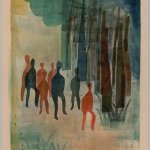
Cheops by J.H. Leopold
In the KB collection, you will find a special edition of the poem 'Cheops' by the poet J.H. Leopold (1865-1925). It was printed in 1916 by De Zilverdistel, the first private press in the Netherlands. Private press is a collective term for amateurs and professionals who owned a printing press at home until 1940 and tried to promote the book as a work of art, or for people who from 1945 onwards printed books for pleasure.

City atlas De Wit
City atlas De Wit is the Google Earth of the 17th century. You can find almost every house, every tree and every back garden of the cities of the Low Countries in it. Look up your birthplace in the old centre of Leiden, for example, or see how the laundry is laid out to dry in the fields outside The Hague.
Shelfmark: KB KW 1046 B 16

Dat heerlijke kerstfeest
Dat heerlijke kerstfeest (That wonderful Christmas) does not mention an author, illustrator, publisher or printer. Originally the book was called O Weihnachtszeit - o sel'ge Zeit. There were also a French and an Italian version. We now know from research that the illustrations were made by Pauli Ebner (1873-1949). She was an Austrian illustrator of picture books and best known for her illustrations on picture postcards.
Shelfmark: KW XKN 406
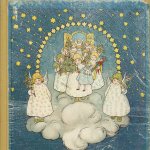
De nieuwe rijschool
De nieuwe rijschool (The new driving school) from 1856 is the oldest known movable picture book made in the Netherlands. Children could make the craziest combinations with the separate parts: the head of a lion with the back of a camel or a rider with the trousers of a clown.
Shelfmark: KW 2281 A 136

Der naturen bloeme by Jacob van Maerlant
Around 1270 Jacob van Maerlant wrote Der naturen bloeme: a medieval encyclopaedia about all the beauty that nature has to offer. The work is written in Dutch. This is exceptional: it is the first text of this genre that has been preserved in the vernacular. The KB owns not 1, but 2 manuscripts of this extraordinary work. Both manuscripts contain beautiful illustrations of animals, trees and people.
Shelfmark: KW KA 16

Donald Duck: the first issue
The weekly magazine Donald Duck first appeared in the Netherlands in October 1952. In 2011, this first Dutch-language issue was chosen as the 'top item with the greatest historical X-factor' by customers of the KB and the National Archives. Despite much discussion on Twitter, the Donald Duck won from the Constitution of 1848 and the Plakkaat van Verlatinge of 1581.
Shelfmark: KW PE 3

Egmond Gospels
The Egmond Gospels are a parchment book from the 9th century. It is famous because it contains a picture of Count Dirk and Countess Hildegard of 'Holland'. They had this picture put in around the year 975. More than 1000 years later, Dirk and Hildegard are the oldest Dutch people of whom a picture exists.
Shelfmark: KW 76 F 1

Flora Batava (1800-1934)
The Flora Batava is a botanical masterpiece: it's the first illustrated overview of the wild flora in our country. Dozens of botanists, artists, colourists and publishers collaborated.

Flora Batava illustrated volumes
The Flora Batava is an overview of Dutch wild plants and flowers. We have digitised all 28 volumes of the original work. You can view it on this page.

Gruuthuse manuscript
The Gruuthuse Manuscript contains a collection of 147 songs, 7 prayers and 16 Middle Dutch poems written around 1400. The manuscript originated in Bruges. Around 1400, Bruges was a rich metropolis bustling with trade, music, art and culture. Therefore, we encounter many themes in the texts that deal with life in the city in the late Middle Ages: religion and love, for example, but also subjects such as drunkenness and sex.

Hansje in 't bessenland
Hansje in ‘t bessenland (Hansel in berry country) is the Dutch translation of a classic Swedish picture book from the beginning of the 20th century. In this picture book you will find verses and prints in Jugendstil style by Elsa Beskow. Johanna Wildvanck translated the text. The book is about Hansje, who searches for berries in the forest for his mother's birthday. With the help of the king of Bessenstein and the Redberry Woman and their children, he manages to fill his baskets and make his mother happy.
Shelfmark: KW BJ Z0668
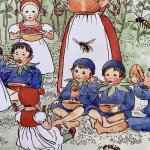
Hoe de vogels aan een koning kwamen
Hoe de vogels aan een vogel kwamen ('How the birds came to a king') is the first picture book by Theo van Hoytema (1863-1917). It's a story about how the birds one day decide to choose a king. That must be the bird that can fly the highest. But is that the eagle? Or the bird that flies on its back? Van Hoytema is known for his color printed lithographs. He first made some samples. This masterpiece from the KB is such a sample.
Shelfmark: KW 2281 A 375

Hot Printing by H.N. Werkman
The art publication Hot Printing by H.N. Werkman is a showpiece in print and stencil work from the 1930s. The colours burst from the pages. This is how Werkman gave these dark times cheerful colours and shapes.
Shelfmark: KW GW X100005

How to be a Dutchie
How to be a Dutchie was made in Amsterdam around 1950 by the unknown writer couple Willy & Luc. The richly illustrated booklet describes the curious mores and habits of the Dutch in a comical manner.
Shelfmark: KB KW 79 H 47
This work contains words that can be perceived as insulting, discriminatory or racist. Read the disclaimer to see how the KB handles these types of texts.

Kleine gedigten voor kinderen
Kleine gedigten voor kinderen is a collection of poems written especially for children. In the 18th century, this was very innovative. These poems appeared between 1778 and 1782. They were written by the jurist Hieronymus van Alphen.
Shelfmark: KW 2220 G 15

Koddige avonturen van den vos en den ooievaar
In the children's book Koddige avonturen van den vos en den ooievaar (The droll adventures of the fox and the stork) children learn how to deal with each other. The last sentence of the book is 'What you do not want to happen to you, do not do to others!' and that is not a coincidence. The book was published in 1859 by Gebroeders Van der Post.
Shelfmark: KW Ki 3230

Korte verhandeling van God, de mensch, en deszelvs welstand by Baruch Spinoza
This masterpiece is the oldest surviving manuscript of the Korte verhandeling van God, de mensch, en deszelvs welstand by philosopher (Short Treatise on God, Man and His Welfare) Baruch Spinoza (1632-1677). It was written in the late 17th century by a copyist on the basis of 2 earlier versions. These were both in Latin, but have been lost. The copyist wrote the Dutch translation in Rijnsburg, near where Spinoza lived and worked.
Shelfmark: 75 G 15

Kunst en samenleving
Kunst en samenleving (Art and Society) is one of the earliest forms of the Nieuwe Kunst (New Art) in the Netherlands. The book was made in 1893, commissioned by Scheltema & Holkema's Boekhandel in Amsterdam.
Shelfmark: KW 1310 F 3

Lancelot compilation
The Lancelot compilation is a Middle Dutch manuscript from around 1320-1330. It was probably made in Antwerp. It contains 10 chivalric novels about King Arthur and the Knights of the Round Table, such as Lancelot and Walewein. The book is the 2nd part of a 2-part set. The 1st part has been lost. The remaining part of the Lancelot compilation is one of the most important sources for Dutch literature in the Middle Ages.
Shelfmark: KW 129 A 10

Le recueil des histoires de Troyes
Le recueil des histoires de Troyes (The collection of stories from Troyes) is a very special book with 48 beautiful woodcuts. It was printed in Haarlem in 1486.
Shelfmark: 78 D 48

Letter of reward for the family of Balthasar Gerards
On 10 July 1584 Balthasar Gerards shot William of Orange on the steps of the Prinsenhof in Delft. For this he received a reward from King Philip II of Spain, who accused William of Orange of high treason. Because Balthasar Gerards was executed shortly after the murder, the reward went to his immediate family. This letter of reward from 1590 is the official declaration of the Spanish king.
Shelfmark: KW 1930 A 008
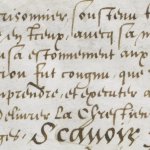
Libelle Magazine
On 13 April 1934, the first issue of Libelle magazine, 'an illustrated weekly for women', appeared. The magazine was an immediate success. It contained articles about housekeeping, (home-made) fashion, family, education, cooking, holidays, royal houses and famous Dutch people. There were also letter columns, reports, stories and puzzles.
Shelfmark: KW DPG 0664

Liber Pantegni
Liber Pantegni is the oldest summary Latin text on medicine from the Middle Ages. It was largely translated from Arabic in the 11th century. That happened in southern Italy. The KB manuscript comes from someone who knew the translator.
Shelfmark: KW 73 J 6

Magazine De Lach
The magazine De Lach (The Laughter) was developed in Amsterdam in 1924. The first issue was published on 21 November 1924, the last issue on 7 April 1972. De Lach started as a magazine for people who liked a joke. The magazine contained cartoons, jokes, anecdotes and short stories. A striking feature of De Lach is the major change it went through: from family magazine to men's magazine.
Shelfmark: KW EE 22

Mare Liberum by Hugo de Groot
Mare Liberum by Hugo de Groot (1583-1645) is a legal text on maritime law, written in Latin. In the text, De Groot, also known as Hugo Grotius, writes that the sea belongs to no one. Therefore, anyone may use the sea.
Shelfmark: KW 893 G 6

Metamorphosis insectorum Surinamensium
Metamorphosis insectorum Surinamensium by Maria Sibylla Merian is a beautifully illustrated book about plants and insects in Surinam from 1705. It is so beautiful that Uitgeverij Lannoo made a facsimile of it in 2016. As a result, this extraordinary book is now available for sale to everyone.

Mijnheer Prikkebeen
Mijnheer Prikkebeen was written by Johan Jacob Anthony Goeverneur. It is considered the first Dutch comic strip. Only, it's not really a Dutch story. The drawings are not Dutch either. The original was written by the Swiss teacher, writer and illustrator Rodolphe Töpffer (1799-1846). He wrote the original under the title Histoire de Monsieur Cryptogame. It was published in the French weekly L'illustration between 25 January and 19 April 1845.
Shelfmark: KW BJ 01955

Nassau-Vianden Book of Arms
The Nassau-Vianden Book of Arms contains coloured drawings of the coats of arms of the ancestors of Engelbrecht II of Nassau (1451-1504). This was a nobleman from Breda. It is a simple, thin booklet. It is a kind of 'family book', with an overview of more than two centuries of famous predecessors.

Nederlandsche vogelen by Nozeman en Sepp
The 5-volume work Nederlandsche vogelen (1770-1829) is the first attempt to give a complete overview of all birds that can be found in the Netherlands.
Shelfmark: 1047 B 10 [-14]

Panorama Magazine
In 1913, the first issue of Panorama magazine, a Roman Catholic weekly for the whole family, appeared. It was a weekly magazine full of photos, which was very modern in those days. The photo reports about the front during the First World War even caused the magazine to appear twice a week for a while. Panorama developed into a 'friend of the house'. It contained comics, tips, cartoons, and a mix of articles for all the family members.
Shelfmark: KW 2281 A 131

Picture book De boerderij
The movable picture book De boerderij (The Farm) from the 19th century shows all aspects of life on the farm. It was published by Hendrik Vleck. With this book, rich people probably taught their children about the ideal farmer's life, and thus about love for the fatherland.
Shelfmark: KW Ki 2627

Picture books made by factories about holidays
Discover 2 picture books made by factories (fabrieksprentenboeken) about holidays from the beginning of the 20th century. In these types of picture books there is no publisher, no printer, no illustrator, no author and no year of publication. They are often issued in a large edition and produced cheaply. These 2 picture books are interesting because they are so rare. In addition, they give a picture of means of transport and ideas about holidays
Shelfmarks: KW XKZ 0214 (Buiten! Waar de vogels fluiten) and KW XKZ 0213 (Hoera! Wij gaan op reis)

Psalter of Eleanor of Aquitaine
The Psalter of Eleanor of Aquitaine is one of the oldest manuscripts in the KB collection. It was created around the year 1185 for Eleanor of Aquitaine, at that time the most powerful woman in Europe.
Shelfmark: KW 76 F 13

Reward letter for the family of Balthasar Gerards
On 10 July 1584, Balthasar Gerards shot and killed William of Orange. He was rewarded for this by king Philip II of Spain. This reward letter from 1590 is the official declaration of the Spanish king.

Simon de Varie's Book of Hours
Simon de Varie's Book of Hours is a manuscript from the mid-15th century. It contains prayers decorated (illuminated) with miniatures. The KB has a large collection of this type of books of hours from the late Middle Ages. Simon de Varie's copy is one of the most beautiful.
Shelfmark: 74 G 37

Sint Nikolaas en zijn knecht
Sint Nikolaas en zijn knecht (Saint Nicholas and his servant) is a children's book from 1850 by Jan Schenkman (1806-1863). The book contains a preface and 16 verses about the saintly man of 12 lines each. It also contains 16 hand-coloured lithographs. These are illustrations made with a special lithography technique. The book became very popular and was reprinted for 50 years. It was also reissued in a modified form.
Shelfmark: KW GW A111695

Specilla circularia
The Specilla circularia is a text about telescopes. The writer is the Amsterdam mayor Johannes Hudde. The work appeared in 1656 and was very innovative at the time. The printed text was missing for years. Until the book showed up at an auction. There the KB could buy it.
Shelfmark: KW GW A108988 [2]

Sprookjes uit de nalatenschap van Moeder de Gans
Sprookjes uit de nalatenschap van Moeder de Gans (Fairy tales from the legacy of Mother Goose) from 1870 is one of the oldest and most beautiful collections of fairy tales by the Brothers Grimm in the KB collection. This edition was published by A.W. Sijthoff in Leiden.
Shelfmark: KW BJ 26563
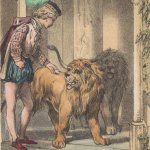
The Book of Hours of Philip of Burgundy
The Book of Hours of Philip of Burgundy is a manuscript from the middle of the 15th century. It contains prayers, psalms and other texts that Catholics recite at fixed times (tides). It was made around 1455-1460 by order of Duke Philip the Good of Burgundy (1396-1467).
Shelfmark: 76 F 2

The Egmond Gospels
The Egmond Gospels is a 9th-century illuminated vellum manuscript famous for its depiction of Count Dirk II and Countess Hildegard of 'Holland'. The two had their likenesses added in 975 and, more than 1,000 years later, they are the oldest surviving images of Dutch people.

Trivulzio book of hours
The Trivulzio Book of Hours was lost, but in 2001, it was unexpectedly donated to the KB. Since then, it has been a true masterpiece in the collection.

Viervoudig schouwspel van wonderen
Viervoudig schouwspel van wonderen (Fourfold spectacle of miracles) is a book by Jan van Call. It contains drawings of cities and landscapes. Van Call makes these drawings around 1700. He then travels along the Rhine, from Schafhaussen to Amsterdam. The drawings are printed in colour. It is one of the earliest experiments with printing in multiple colors.
Shelfmark: KW 2211 B 24

Visboeck by Adriaen Coenen
The Visboeck by Adriaen Coenen (1514-1587) is a manuscript from 1579 about sea creatures. It is about fish, but also about animals and people who have a close connection with the sea (for example, the Inuit from Greenland). Coenen gives a description of the animals and people, with as many characteristics as possible. He provides this information with colourful illustrations, which are also very accurate.
Shelfmark: KW 78 E 54

Wat is er op de kermis te zien?
Wat is er op de kermis te zien? (What is there to see at the fair?) is a rare picture book from the 19th century. It contains 16 coloured pictures about the funfair. These pictures take up a whole page. It is actually 2 books in one. At the back, you will find a unique sequel. This is called Nog iets van de kermis in prentverbeeldingen (Another thing about the funfair in prints).
Shelfmark: KW 1088 E 30
This work contains words that can be perceived as insulting, discriminatory or racist. Read the disclaimer to see how the KB handles these types of texts.
